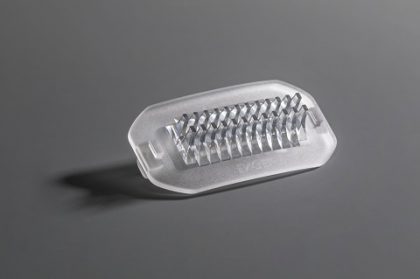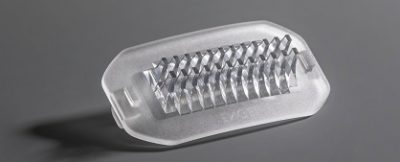 Liquid Silicon Lenses (LSR) can be processed efficiently in injection moulding and also scores with excellent material resistance. LSR is therefore becoming increasingly important as a material for optical lenses in lighting technology. By manufacturing LED headlamp lenses on a tie-bar-less ENGEL e-victory 310/120 injection moulding machine in an automated, rework-free process, the injection moulding machine manufacturer and system solution provider ENGEL, headquartered in Austria, is demonstrating at Chinaplas 2019 in Guangzhou, China, from 21st to 24th May, how geometrically highly complex LSR products can be manufactured economically in large quantities.
Liquid Silicon Lenses (LSR) can be processed efficiently in injection moulding and also scores with excellent material resistance. LSR is therefore becoming increasingly important as a material for optical lenses in lighting technology. By manufacturing LED headlamp lenses on a tie-bar-less ENGEL e-victory 310/120 injection moulding machine in an automated, rework-free process, the injection moulding machine manufacturer and system solution provider ENGEL, headquartered in Austria, is demonstrating at Chinaplas 2019 in Guangzhou, China, from 21st to 24th May, how geometrically highly complex LSR products can be manufactured economically in large quantities.
The automotive industry is one of the pioneers when it comes to exploiting optical silicones for lighting systems. In addition to this, LSR is also becoming increasingly important as a lens material for street and building lighting. Like the established thermoplastic lens materials PMMA and polycarbonate, silicone offers significant weight savings compared to glass. However, LSR is superior to organic polymers in terms of thermal and chemical resistance. Highly transparent grades for optical applications have a lower yellowing index than thermoplastic lens materials. They are extremely resistant to environmental influences such as UV radiation and can be used over a wide temperature range from -40 to +200 °C. In addition, they allow particularly flexible design. In terms of the geometry, there are almost no limits when processing LSR in injection moulding.
During the four days of the fair, ENGEL will be processing Dowsil MS-1002 Moldable Silicone by Dow Silicones (Wiesbaden, Germany), a material developed specifically for use on injection moulding machines. The curing speed has been optimised to obtain a smooth and very hard surface similar to thermoplastic. The high light transmission ensures a very good luminous efficiency. In addition, the high thermal stability enables an outstanding transparency. The surface, with its extremely filigree structure, is moulded with highest reproducibility. The LED lenses leaving the production cell are ready for installation.
 Tie-bar-less technology as an efficiency factor
Tie-bar-less technology as an efficiency factor
“The prerequisites for economically producing geometrically demanding products from liquid silicone are automated, rework-free processes as well as high precision and stability of the injection moulding process,” as Gero Willmeroth, the President East Asia and Oceania of ENGEL, based in Shanghai, emphasises. “Thanks to its tie-bar-less clamping unit, the e-victory machine with an electric injection unit is predestined for this.”
Tie-bar-less injection moulding machines offer a number of advantages for processing LSR. The fact that the robot can reach the cavities directly from the side without having to circumvent any obstacles reduces the handling time, and therefore the mould opening time. On top of this, the tie-bar-less technology allows for particularly compact production cells. Because there are no tie bars in the way, the mould mounting platens can be fully used up to their very edges. This means that the high-volume lens mould necessitated by the complex component structure fits on a comparatively small 120 ton injection moulding machine.
One of the reasons for the accurate reproduction of surface detail is the outstanding parallelism of the mould mounting platens. The patented force divider ensures that the moving mould mounting platen follows the mould precisely while clamping force is building up and that the force introduced is evenly distributed across the platen surface. When multi-cavity moulds are used, the parting lines of all cavities experience the same surface pressure.
This prevents flash when processing very low-viscosity silicones, and avoids reworking of the injection moulded parts.
Please read more from “SOURCE“













